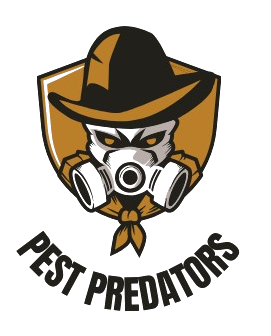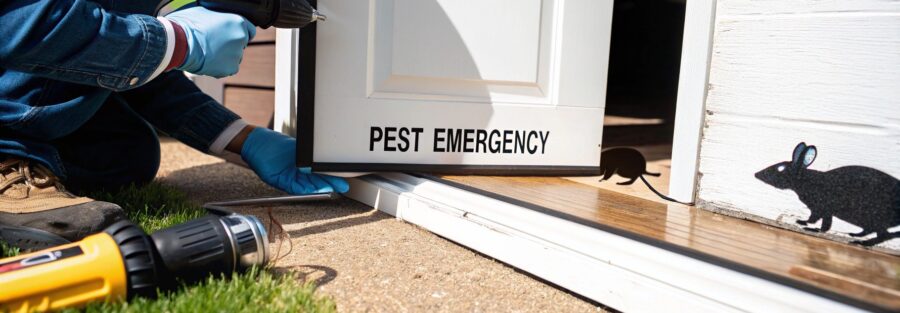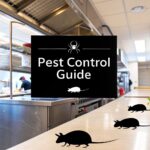A pest control emergency isn't just a nuisance—it's any sudden infestation that poses an immediate threat to your health, safety, or property. This could be anything from a wasp nest right by your front door to the chilling discovery of rats in your kitchen. These situations require urgent professional help to prevent real harm or serious damage.
Your Immediate Response to a Pest Emergency
That moment of panic when you see a swarm of insects or hear that unmistakable scratching in the walls is completely normal. The trick is to take a breath, stay calm, and follow a few measured steps. Your goal right now isn't to solve the problem yourself, but to manage the situation safely and stop it from getting worse while you wait for the experts.

Assess the Situation From a Distance
Your first instinct might be to get a closer look, but it’s vital to keep a safe distance. Don't touch or try to handle any pests, nests, or droppings directly. Instead, observe from afar to gather some crucial information. See if you can pinpoint where the pests are concentrated and how they might be getting in.
Think of this as gathering intelligence for the pest controller. Try to note the type of pest if you can, but don’t guess. For instance, telling a professional you have a wasp nest versus a bee swarm is critical information, as bees are often protected and need a specialist approach for relocation, not extermination.
To help you make a quick, safe assessment, here's a simple guide to some common emergency pests and the risks they bring.
Emergency Pest ID and Initial Risk Guide
| Pest Type | Common Signs | Immediate Health or Property Risk |
|---|---|---|
| Rats & Mice | Droppings, gnaw marks, scratching sounds, shredded materials for nesting. | Disease transmission (e.g., Salmonella, Weil's disease), food contamination, fire hazard from gnawed wires. |
| Wasps & Hornets | Visible nests (in eaves, lofts, sheds), constant buzzing, aggressive behaviour near the nest. | Painful stings, potential for severe allergic reactions (anaphylaxis), risk of swarming attacks. |
| Bed Bugs | Small reddish-brown insects, bites on skin, tiny blood spots on bedding, musty odour. | Severe itching and skin irritation, allergic reactions, rapid spread to other rooms and furniture. |
| Cockroaches | Unpleasant odour, droppings resembling coffee grounds, sightings in kitchens or bathrooms at night. | Spreading bacteria like E. coli and Salmonella, triggering asthma and allergies. |
This table isn't exhaustive, but it covers some of the most urgent situations we see. No matter what you're facing, the next steps are all about safety.
Implement Immediate Safety Precautions
The safety of your family and pets is the absolute top priority. Your immediate actions should be focused on creating a secure environment until help arrives.
- Isolate the area: If you can, shut the door to the room where the pests are. A towel pushed under the door can help block any gaps and contain them.
- Keep everyone away: Make sure children and pets are kept well clear of the affected area. This is the best way to minimise the risk of bites, stings, or exposure to diseases carried by pests like rodents.
- Avoid DIY chemicals: It's tempting to grab a can of insecticide, but please don't. Using the wrong product can be totally ineffective, scatter the pests and make the infestation worse, or even pose a health risk to your household.
A common mistake in a pest control emergency is trying to handle it alone. A panicked response can quickly turn a manageable problem into a much larger, more dangerous one. Your primary job is to secure the area and call for expert help.
How to Safely Contain the Infestation
Right, you’ve taken a deep breath and figured out what you're dealing with. Now, the absolute priority is containment. This isn’t about winning the war just yet; it's about winning the first battle by stopping the pests from spreading further into your home. Think of it as putting up a temporary barricade, buying yourself precious time before the professionals arrive for your pest control emergency.
It doesn't have to be complicated. If you've found signs of rodents, something as simple as heavy-duty duct tape across the bottom of the door can work wonders. For crawling insects like ants or cockroaches, a thick line of petroleum jelly across a doorway threshold creates a surprisingly effective barrier they really don't want to cross. The goal here is simple: isolate the problem.

What Not to Do
When panic sets in, it's all too easy to make things worse. The biggest mistake we see homeowners make is reaching for over-the-counter aerosol sprays or "bug bombs." These products are notorious for causing pests like cockroaches and bed bugs to scatter, driving them deeper into wall cavities and other rooms. This just makes the professionals' job ten times harder.
Your containment efforts should be simple, physical barriers. Steer clear of any chemical treatments, as they can interfere with professional-grade products and actually spread the infestation. Your aim is to isolate, not agitate.
Pest-Specific Containment Tips
Different pests need different tactics. While you wait for us to get there, here are a few practical things you can do:
- Rodents (Rats and Mice): Find any visible entry points into the room and stuff them tightly with steel wool. It’s one of the few things they can't chew through.
- Wasps: If they’ve managed to get inside, close the door to that room immediately and wedge a towel along the bottom. Whatever you do, do not try to block the entrance to an external nest. That's a sure-fire way to get stung.
- Cockroaches: Be meticulous. Seal every last bit of food in airtight containers and wipe up any crumbs or spills straight away. Cut off their food supply.
Pest emergencies are becoming more common. In 2024, UK local authorities were called out to a staggering 291,132 homes—that's a visit every two minutes. Unsurprisingly, rodent cases made up 91% of those calls.
While you're waiting for help to arrive, or if you're tackling a less severe issue on your own, knowing how to contain the problem is crucial. For a more aggressive strategy against smaller nuisances, this comprehensive guide to controlling common household pests like fruit flies has some excellent tips.
Documenting the Problem for Professionals
When you call in the pros for a pest emergency, the information you give them is gold. A clear picture helps the technician show up ready to go, armed with the right tools and a solid plan. Think of yourself as a detective, gathering clues from a safe distance.
Your phone is your best tool here. From a secure spot, take a few clear photos or a short video. Try to capture the pest itself, but don't forget the evidence they leave behind—droppings, gnawed wires, or shredded bits of packaging are all vital clues. Don't ever risk getting too close for the perfect shot; a zoomed-in photo is far better than a nasty bite or sting.
Create a Log of Pest Activity
Beyond just photos, a few scribbled notes can make all the difference. This helps professionals spot patterns and figure out how the pests are getting in and where they're hiding. You don’t need a detailed report, just a quick list.
- Locations: Where have you seen them? Be specific. "Under the kitchen sink" is much more helpful than just "the kitchen."
- Timings: Are they party animals, showing up mostly at night? Or are they early risers? Noticing a pattern is a massive help.
- Sounds: Have you heard any scratching, scurrying, or buzzing? Pinpoint where the sound is coming from if you can.
- Numbers: Is it a lone wanderer or an army? A rough idea of numbers helps the team gauge the scale of the infestation right away.
Getting the identification right is also a huge part of this. For instance, if you're struggling with identifying mysterious brown bugs that look like roaches, getting an expert opinion is crucial.
Passing this log over to your pest control team lets them build an effective strategy before they even set foot in your home. It's the key to a faster, more successful treatment.
Finding a Reputable Emergency Pest Service
When you’re facing a pest control emergency, it’s tempting to dial the first number you find. I get it. The panic is real. But taking just a couple of minutes to check who you’re hiring can save you from a much bigger nightmare down the road.
A true professional will get the job done right—safely and for good. A "cowboy" operator, on the other hand, could make things ten times worse.
First things first, look for credentials. Is the company a member of a recognised trade body, like the British Pest Control Association (BPCA)? Membership means they follow a strict code of conduct and are properly trained and insured. It's a quick and easy way to filter out the amateurs.
Key Questions for Your First Call
Once you have someone on the phone, don't be shy. A few direct questions will tell you everything you need to know about their competence and whether they’re the right fit for your specific crisis.
Here’s what I’d ask:
- Experience: "Have you dealt with a severe [your pest] infestation in a property like mine before?"
- Availability: "What's your genuine call-out time for my area right now?"
- Methods: "What treatment methods do you use, and are they safe for my children and pets?"
- Qualifications: "Are your technicians certified? For example, with an RSPH Level 2 Award in Pest Management?"
Their answers will quickly separate the real experts from the chancers. The UK's pest control market is growing, with projections showing a 6.5% annual growth rate through to 2035, partly driven by rising urban pest problems. You can learn more about these market trends and their impact on UK pest services.
Unfortunately, that growth means more unqualified people are trying to cash in on homeowners' desperation.
Be very wary of any company that gives you a vague quote over the phone without asking lots of questions first. A reputable service will always need to understand the scale of your problem before they can talk about a price or a plan.
Finding a team you can trust is crucial for your peace of mind. For immediate, professional assistance from qualified technicians, you can explore options like our dedicated emergency pest control service to ensure you get the right help, fast.
Preparing Your Home for the Professionals
So, you’ve booked your emergency pest control service. What now? Taking a few simple steps to prepare your home can make a massive difference to how well the treatment works. This isn’t just about having a quick tidy-up; it’s about giving our technicians clear access and keeping your family and pets safe. A properly prepped home almost always means a faster, more successful outcome.

Think of it as clearing the way for the experts. Technicians need to get right into the skirting boards, corners, and under furniture—all the places pests love to hide. Just pulling sofas and cabinets about a foot away from the walls can be a huge help.
A Quick Preparation Checklist
Your technician will always give you specific instructions, but here are some solid general guidelines that cover most situations:
- Kitchens: Clear every single worktop. All food, dishes, and utensils need to be tucked away in cupboards or stored in sealed plastic boxes.
- Living Areas: Pull furniture away from the walls and clear the floors of anything that can be moved, like toys and pet beds.
- Bedrooms: If we're treating for bed bugs, strip all the bedding and get it ready for a hot wash, following the technician's advice.
- Pets and Children: This one’s crucial. Please arrange for them to be out of the house during the treatment and for the recommended period afterwards.
Following these steps does more than just help the technician; it protects your belongings and ensures that the treatment can be applied exactly where it’s needed most, leading to a faster resolution of your pest control emergency.
The professional products we use are highly regulated for both safety and effectiveness. This is all part of a wider commitment to sustainable pest management, as set out in the UK's strategic plans to tackle infestations while minimising environmental risks. If you're interested, you can read more about the UK’s commitment to safer pest control on GOV.UK.
Every pest problem is unique, so listening to your technician is vital. They might have slightly different prep needs depending on what they find. For a better idea of what to expect, have a look at our various professional pest control services to see how we handle different types of infestations.
So, the professionals have packed up and gone, but your job isn’t quite done yet. What you do in the hours and days right after a treatment is absolutely crucial for making sure the problem is gone for good and your home is safe for the family.
Following the aftercare instructions from your technician isn't just a suggestion—it's the key to solving your pest control emergency once and for all.
First things first: ventilation. Your technician will give you a specific timeframe for airing out your home, so get those windows and doors open as advised. This helps any lingering odours or fumes clear out safely. It might be tempting to start scrubbing, but hold off on cleaning treated areas like skirting boards or the corners of your kitchen. Many professional products are designed to work over time, and wiping them away too soon will just undo all that good work.
Keeping an Eye on Things
You might still spot a few pests in the days that follow. Don't panic! This is often normal as they emerge and come into contact with the treated surfaces. The real sign of success is a sharp drop in activity or finding dead pests, so keep a lookout.
Now is also the perfect time to start thinking about long-term prevention. Once the treatment has had time to work its magic, you might need to do a deep clean. If you’re dealing with any stubborn marks or residue left behind, you can find some great advice on how to remove stubborn stains.
Think of a professional treatment as hitting the reset button. It’s the follow-up actions you take—from cleaning up to sealing entry points—that will stop the problem from coming back.
Getting ahead of future infestations is what really matters. For a deeper dive into managing specific pests and what to expect financially, our guide on the pest control cost for rats has some really useful information.
Got a Pest Emergency? Here Are the Answers You Need
When you’re staring down a sudden pest problem, your mind starts racing. It’s a stressful, overwhelming moment, and getting clear answers can make all the difference. We get these calls all the time, so let’s walk through the most common questions homeowners have when a pest crisis hits.
How Quickly Can an Emergency Pest Controller Get Here?
In the UK, most professional pest control companies will aim to get to you within a few hours for a genuine emergency, and many offer same-day service. Of course, response times can depend on where you are and how busy the technicians are, but a true emergency service will always shuffle things around to prioritise your call.
When you ring up, make it clear what’s happening and ask for an estimated arrival time. You need to know what to expect.
Situations that pose a direct health risk—like a rat scurrying across your kitchen floor or an angry wasp nest right by your front door—are always bumped to the top of the list. Any decent firm understands the urgency and will get a technician out to you as fast as they can.
What Actually Counts as a Pest Control Emergency?
Look, not every pest sighting is a code-red situation. A true pest control emergency comes down to one thing: an immediate and serious threat to your health, safety, or property. It’s all about the context.
The key factors are the type of pest, the scale of the infestation, and its location in your home. A single spider in the bath is just a nuisance; a massive, buzzing wasp nest above your main entrance is a genuine emergency that needs professional help, pronto.
Let’s put it in real terms:
- Emergency: Finding rat or mouse droppings in your kitchen cupboards. That’s a direct risk of food contamination.
- Not an Emergency: Seeing a few ants on the patio. Annoying, yes, but not a crisis.
- Emergency: Discovering bed bugs in a bedroom. They spread like wildfire and cause huge amounts of stress.
Is It Safe for My Family and Pets to Be at Home During Treatment?
For nearly every professional treatment, the answer is a firm no. It’s almost always recommended that people and pets leave the property while the work is being done. Your technician will give you very specific, non-negotiable instructions based on the products they need to use. Your family’s safety is the absolute top priority.
For example, if we’re using insecticidal sprays, you’ll likely need to stay out for several hours. This gives the product time to dry completely and allows us to ventilate the area properly before it’s safe for you to come back inside. Always follow the expert’s advice to the letter—it’s there to protect you.
If you're facing a sudden pest problem and need expert help right away, don't wait for it to get worse. Pest Predators Limited offers rapid, effective, and safe solutions to protect your home and family. Contact us now for immediate assistance.



